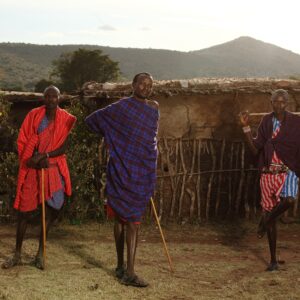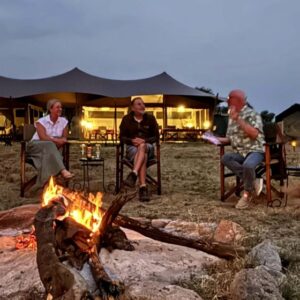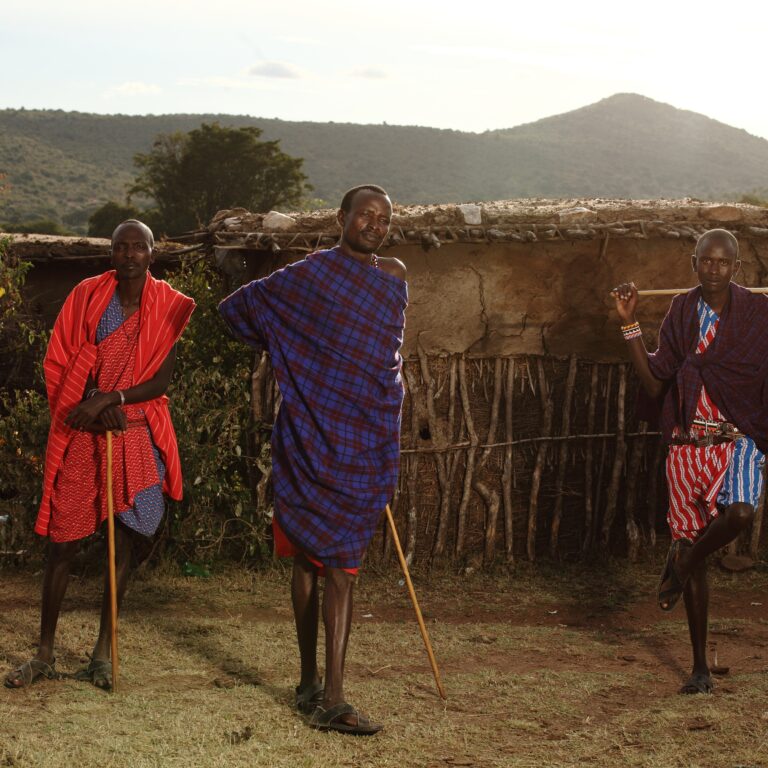Explore Serengeti National Park – Travel Guide, Map & More!
The name “Serengeti” conjures images of endless plains stretching to the horizon, dotted with acacia trees, and teeming with an astonishing abundance of wildlife. It is the heart of Africa’s most iconic safari destination, a UNESCO World Heritage Site, and the stage for the planet’s greatest terrestrial wildlife spectacle: the Great Wildebeest Migration. More than just a national park, the Serengeti is a living, breathing testament to the raw power and beauty of the natural world, offering an unparalleled safari experience that etches itself into the very soul of every visitor. This comprehensive guide will take you on a journey through the Serengeti, unveiling its diverse ecosystems, incredible wildlife, and all the essential information you need to plan your unforgettable adventure.
1. Overview – Serengeti National Park
Encompassing approximately 14,763 square kilometers (5,700 sq mi) of savanna, grassland, and riverine forests, Serengeti National Park is a vast protected area in northern Tanzania. Established in 1951, it is arguably the most famous national park in Africa, celebrated globally for its pristine ecological balance and, of course, the annual Great Migration.
The park’s name itself, “Serengeti,” is derived from the Maasai word “Siringet,” meaning “the place where the land runs on forever” – a perfect description of its sweeping plains. This immense ecosystem supports an extraordinary density and diversity of wildlife, including the “Big Five” (lion, leopard, elephant, rhino, buffalo) and countless other species, making every game drive a discovery. Beyond the wildlife, the Serengeti’s landscapes are breathtaking, offering endless photographic opportunities from dramatic sunrises to golden sunsets over the vast plains.
2. Safari Reviews – Serengeti National Park
Safari reviews for Serengeti National Park are overwhelmingly positive, consistently praising its phenomenal wildlife viewing, breathtaking scenery, and the sheer scale of the wilderness. Visitors frequently describe it as a “life-changing experience,” “the ultimate safari destination,” and “nature at its finest.” The opportunity to witness the Great Migration, especially the river crossings, is often cited as the pinnacle of their journey.
However, some reviews also touch upon the park’s popularity, particularly during peak migration seasons (e.g., July-October for the Mara River crossings, February for calving season in Ndutu). This can sometimes lead to multiple safari vehicles at a single sighting. Despite this, the vastness of the park means that it’s often possible to find quieter areas, and the quality of guiding typically ensures that visitors feel immersed in the wilderness. Many reviewers highlight the knowledgeable guides, comfortable accommodations, and the overall sense of wonder that pervades a Serengeti safari. The consensus remains: the Serengeti delivers an unparalleled wildlife spectacle.
3. Wildlife & Animals – Serengeti National Park
The Serengeti is synonymous with abundant wildlife, and its ecosystem supports an incredible array of species, making it a dream destination for any wildlife enthusiast.
The Big Five: All five of Africa’s iconic “Big Five” (lion, leopard, elephant, rhino, buffalo) are found here, with excellent chances of sighting most of them.
Lions: The Serengeti boasts one of the highest densities of lions in Africa. Large prides are commonly seen resting on kopjes (rocky outcrops), stalking prey on the plains, or interacting near watering holes.
Leopards: While elusive masters of camouflage, the Serengeti’s leopards are relatively numerous, particularly in the riverine forests of the Seronera Valley. They are often spotted resting on acacia branches, a classic safari image.
Elephants: Large herds of African elephants roam the plains, especially abundant in the central and northern regions.
Buffalo: Huge herds of Cape buffalo are a common sight across the park.
Black Rhinos: The critically endangered black rhino is present in the Serengeti, primarily protected in specific areas like the Moru Kopjes, offering a rare and precious sighting.
The Great Migration: The park is home to the world’s largest terrestrial mammal migration, involving over 1.5 million wildebeest, accompanied by hundreds of thousands of zebras and gazelles. This continuous cycle of movement in search of fresh grazing drives much of the park’s dynamic predator-prey interactions.
Other Predators: Beyond the big cats, the Serengeti is home to cheetahs (often seen hunting on open grasslands), numerous clans of spotted hyenas (highly successful hunters), jackals (black-backed and golden), and the elusive African wild dog (though less common than in southern parks).
Herbivores: A vast array of herbivores includes giraffes (Maasai giraffe), various antelope species (elands, impalas, topis, hartebeest, dik-diks, waterbucks), hippos (found in rivers and pools), and warthogs.
4. Birds – Serengeti National Park
The Serengeti is not just a haven for mammals; it’s also a birdwatcher’s paradise, boasting over 500 recorded bird species, making it one of the richest birding regions in East Africa. Raptors. The skies are dominated by magnificent raptors, including various eagle species (Martial, Tawny, African Fish Eagle), vultures (Lappet-faced, White-backed, Rüppell’s Griffon Vultures), and buzzards.
Plains Birds. On the grasslands, you’ll encounter iconic species like the majestic Kori Bustard (Africa’s heaviest flying bird), ostriches, secretary birds, and various francolins and guinea fowl. Water Birds. Seasonal swamps, rivers, and the Grumeti and Mara rivers attract a variety of storks (Marabou, Yellow-billed), pelicans, kingfishers, and various ducks and geese.
Endemic Species. Look out for endemic species like Fischer’s lovebird and the Grey-breasted spurfowl. Migratory Birds. From November to April, migratory birds from Europe and North Africa swell the resident bird population, offering even more diverse sightings.
5. Best Time to Visit – Serengeti National Park
The Serengeti offers excellent wildlife viewing year-round, but the “best time” often depends on what you wish to see, particularly regarding the Great Migration.
Peak Wildlife Viewing (Dry Season: June to October)
Pros. Vegetation is sparse, making animals easier to spot as they congregate around predictable water sources. The weather is generally dry, sunny, and pleasant. This period encompasses the famous Mara River crossings (July-October). Cons. It can be more crowded, especially around popular sights and river crossing points. Accommodation prices are at their highest.
Calving Season & Lush Scenery (Wet Season: December to March):
Pros. The short-grass plains of the Southern Serengeti (especially Ndutu) become the calving grounds for millions of wildebeest, offering incredible scenes of birth and intense predator action (lions, hyenas, cheetahs). The landscape is lush and green, creating stunning photographic backdrops. Fewer tourists compared to the dry season, and often lower prices. Migratory birds are present. Cons. Roads can be muddy, potentially impacting accessibility in some areas. Short, heavy downpours can occur, though usually not continuously.
Shoulder Seasons (April-May & November)
Pros. Fewer crowds, lower prices. Lush landscapes. Good general game viewing. Cons. It can be challenging for migration viewing as herds are dispersed or rapidly moving. April and May are the peak of the long rains, making roads difficult. Dramatic river crossings, aim for July to October in the Northern Serengeti. The incredible calving season and intense predator action target February-March in the Southern Serengeti/Ndutu area. General excellent game viewing without a specific migration focus, the central Seronera region is fantastic year-round.
6. Weather & Climate – Serengeti National Park
The Serengeti experiences a tropical climate with two distinct seasons. The Dry Season (June to October). Temperatures: Daytime temperatures are pleasant, averaging 20-28°C (68-82°F). Nights and early mornings can be cool, especially in July and August, dropping to 15-20°C (59-68°F). Rainfall: Very little to no rainfall. The landscape turns golden brown and dusty. Wet Season (November to May). Short Rains (November to December): Characterized by short, localized showers. Temperatures remain warm. Long Rains (March to May). The wettest period, with heavier, more consistent rainfall, often in the form of afternoon thunderstorms. Temperatures are warm and humid. General. Due to its vastness, microclimates can exist. Always pack layers, as temperatures can fluctuate significantly from early morning game drives to midday heat.
7. Getting There – Serengeti National Park
Accessing the Serengeti is most commonly done via internal flights or road transfers from Arusha. International Gateway. Most international flights arrive at Kilimanjaro International Airport (JRO), near Arusha.
Internal Flights (Recommended for time efficiency). Light aircraft flights operate daily from Arusha Airport (ARK) or Kilimanjaro International Airport (JRO) to various airstrips within the Serengeti, such as Seronera (central), Kogatende (north), and Ndutu (south).
These flights save considerable driving time (e.g., Arusha to Seronera is a 5-6 hour drive; by air, it’s about 1 hour). Direct flights also connect the Serengeti airstrips to Zanzibar, allowing for seamless safari and beach combinations.
Road Transfers:
For the initial part of a Northern Circuit safari, transfers from Arusha to Tarangire, Lake Manyara, and Ngorongoro Crater are done by 4×4 safari vehicle.
The drive from Ngorongoro Conservation Area to the Serengeti (Seronera) is approximately 3-4 hours, often including an “en route” game drive.
Longer drives are required if moving between distant regions of the Serengeti by road (e.g., Seronera to Kogatende can be 4-6 hours).
8. Malaria & Safety – Serengeti National Park
Malaria. The Serengeti National Park is located in a malaria risk zone. It is highly recommended to consult your doctor or a travel clinic at least 4-6 weeks before your trip for advice on malaria prophylaxis (anti-malarial medication). In addition:
Use insect repellent containing DEET.
Wear long sleeves and trousers at dawn and dusk.
Sleep under mosquito nets (most lodges/camps provide these).
Safety:
Wildlife. Always remember you are in a wild environment with dangerous animals. Never exit your safari vehicle unless at designated picnic areas or under explicit instruction from your guide.
Listen to your Guide. Your safari guide is highly trained and experienced. Always follow their instructions regarding animal behavior and safety protocols. Their priority is your safety.
Unfenced Camps. Many tented camps in the Serengeti are unfenced, meaning wild animals can roam through the property, especially at night. Always accept an escort from lodge staff to and from your tent after dark.
Respectful Viewing. Maintain a respectful distance from wildlife. Avoid loud noises, sudden movements, or attempting to attract animals’ attention.
Travel Insurance: Comprehensive travel insurance, including medical evacuation, is absolutely essential for any safari to Tanzania.
9. Accommodations – Serengeti National Park
The Serengeti offers a wide range of accommodation options, catering to various budgets and preferences, from basic campsites to ultra-luxury lodges. Your choice often dictates the style of your safari and your proximity to the wildlife.
Mobile Tented Camps. Philosophy: These camps move seasonally to follow the Great Wildebeest Migration, ensuring you are always in the best possible location for migration viewing. Style. Ranging from comfortable to ultra-luxury. They offer spacious canvas tents with proper beds, en-suite bathrooms (often with bucket showers or plumbed facilities), and attentive service. They provide an intimate, authentic “under canvas” experience. Examples: Sanctuary Kichakani Serengeti Camp, Mara Under Canvas, Ndutu Under Canvas, Nyasi Migrational Camp, Serian The Original, Lemala Mara Camp, Serengeti River Camp.
Permanent Tented Camps. Philosophy. Fixed structures offering a “tented” feel with more permanent amenities. They are usually located in areas with excellent year-round resident game. Style. Very comfortable, often with solid floors, en-suite bathrooms, and amenities like swimming pools and charging facilities. Serengeti Kati Kati Camp, Ang’ata Serengeti Camp, Kubu Kubu Tented Lodge, Lahia Tented Lodge, Dunia Camp.
Luxury Lodges. Philosophy. Offer resort-style amenities and comfort in the heart of the wilderness. Style. Solid structures with extensive facilities, including swimming pools, spas, multiple restaurants, and often air conditioning. Four Seasons Safari Lodge Serengeti, Melia Serengeti Safari Lodge, Serengeti Serena Safari Lodge.
Private Concessions / Exclusive Reserves. Philosophy. Located adjacent to the main park (e.g., Grumeti Reserves), these offer exclusive access, fewer vehicles, and often allow off-roading and night drives. Style. Typically ultra-luxury, offering bespoke experiences and unparalleled privacy. Singita Sasakwa Lodge, Mwiba Lodge (in Mwiba Wildlife Reserve). Public Campsites. For budget safaris, public campsites (e.g., Seronera Public Campsite, Kogatende Public Campsite) offer basic facilities, requiring a full camping setup by your tour operator.
10. Safari Packages – Tailoring Your Serengeti Experience
Serengeti safari packages are highly customizable to suit various traveler types and budgets, often combining the park with other highlights of Tanzania’s Northern Circuit.
Family Safaris: Focus on family-friendly lodges with kids’ clubs, swimming pools, and flexible game drive schedules. Often involve private vehicles to allow for spontaneity. Honeymoon/Couple Safaris: Emphasize intimate, romantic lodges, often with private dinners, hot air balloon safaris, and luxurious amenities. Luxury Safaris: Feature stays in ultra-exclusive lodges (like Singita Sasakwa or Sayari), private vehicles, and often include internal flights for maximum comfort and efficiency.
Seniors Safaris: Prioritize comfort, ease of movement, and sometimes slower-paced itineraries. Lodges with good accessibility and amenities are key. Student/Budget Safaris: Typically involve camping or staying in simpler tented camps, often with shared game drives to minimize costs. Mid-range Safaris: A popular choice, balancing comfort and amenities with affordability, often utilizing permanent tented camps or solid lodges.
Most packages include all park fees, accommodation, meals, game drives in 4×4 vehicles, and a professional safari guide. Flights (international and sometimes internal), drinks, and tips are usually extra.
11. Areas/Regions in Serengeti National Park
The Serengeti’s vastness means its different regions offer unique characteristics and are crucial for understanding the Great Migration’s movements.
Central (Seronera) Serengeti. Characteristics: The heart of the Serengeti, characterized by the Seronera River valley, open grasslands, and scattered kopjes. Wildlife: Renowned for its abundant resident wildlife year-round, particularly high concentrations of predators (lions, leopards, cheetahs) due to permanent water and varied prey. It’s an excellent place to see the Big Five. Migration (Seasonal). The migration passes through Seronera during its northward and southward movements (typically April-May and October-November), but it’s not a primary “migration hotspot” like the north or south. Accommodation. Has the widest range of accommodation options, from budget campsites to luxury lodges.
Western Corridor and Grumeti: Characteristics. Defined by the Grumeti River and its surrounding woodlands and plains. Wildlife. Known for large resident herds, and the iconic Grumeti River crossings of the Great Migration (typically May-July), where wildebeest face massive crocodiles. Migration (Seasonal).A crucial choke point for the migration as herds move north, offering dramatic crossing opportunities. Accommodation. Features exclusive lodges and camps, including those within private concessions like Grumeti Reserves.
Northern Serengeti National Park (Lobo area & Kogatende). Characteristics. Undulating hills, riverine forests, and the famous Mara River. The Lobo area is south of the Mara River, while Kogatende is right on its banks. Wildlife. Excellent resident game, but most famous for the spectacular Mara River crossings of the Great Migration (typically July-October), as millions of animals attempt to cross into Kenya’s Maasai Mara and back. High predator density during this period. Migration (Seasonal). The absolute prime location for witnessing the most dramatic phase of the migration. Accommodation. Many luxury mobile camps move here for the season, along with exclusive permanent lodges like Sayari Camp.
Southern (Ndutu) Serengeti National Park. Characteristics. Short-grass plains stretching into the Ngorongoro Conservation Area. Wildlife. During the wet season (December-March), this area becomes the calving grounds for the Great Migration, with thousands of wildebeest calves born daily. This attracts a very high concentration of predators (lions, cheetahs, hyenas) seeking easy prey. Migration (Seasonal). The primary focus for the calving season and intense predator action. Accommodation. Features mobile camps that set up seasonally, and permanent lodges around Lake Ndutu.
Eastern Serengeti National Park. Characteristics: More open, sometimes drier plains, with scattered acacia woodlands. Less visited than other parts of the park. Wildlife. Good resident game, known for cheetahs and wild dogs, and historically an important area for the migration during certain transitional periods (October-November). Migration (Seasonal). Herds sometimes pass through here during the southward migration. Accommodation. Fewer camps, offering a more remote and exclusive experience.
Is Serengeti National Park safe for tourists? Yes, it is very safe. Tour operators adhere to strict safety protocols, and guides are highly trained. The primary rule is to remain inside your safari vehicle unless at designated safe areas.
Do I need a visa for Tanzania? Most nationalities require a visa for Tanzania. It’s best to apply for an e-visa online in advance.
What should I pack for a Serengeti safari? Neutral-colored, lightweight clothing (layers are key!), a warm jacket for cool mornings/evenings, a wide-brimmed hat, sunglasses, high-SPF sunscreen, insect repellent, comfortable closed-toe shoes, a camera with a good telephoto lens, extra batteries, and binoculars.
Can I see the Big Five in the Serengeti? Yes, the Serengeti is one of the best places in Africa to see all of the Big Five, with excellent chances for lions, leopards, elephants, and buffalo. Rhino sightings are less common but possible, especially in protected areas.
Is it possible to see the Wildebeest Migration all year round? Yes, the Great Wildebeest Migration is a continuous, year-round cycle. However, its location within the vast Serengeti ecosystem changes throughout the year, driven by rainfall and fresh grazing. Your safari operator will advise on the best region to visit based on your travel dates.
Are night drives allowed in Serengeti National Park? No, night drives are generally not permitted within the main Serengeti National Park. However, some private concessions bordering the park (e.g., Grumeti Reserves, Mwiba Wildlife Reserve) do offer night drives, providing unique opportunities to see nocturnal animals.
The Serengeti National Park is more than just a destination; it’s a profound journey into the heart of wild Africa. Its vastness, its legendary wildlife, and the eternal drama of the Great Migration combine to create an experience that will stay with you long after you’ve left its golden plains.








